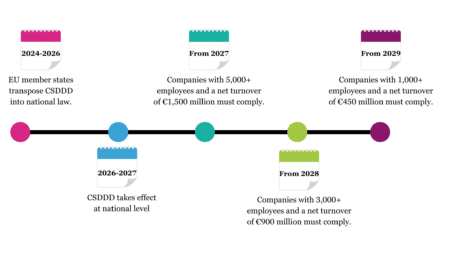The Corporate Sustainability Due Diligence Directive (CSDDD) is poised to be a game-changer for businesses across the globe. Expected to be ratified by the European Parliament and European Council ahead of the 2024 EU elections*, it aims to significantly enhance corporate accountability for human rights and environmental impacts throughout global value chains. Understanding and preparing for the CSDDD’s implications is crucial for businesses.
What is the EU CSDDD?
In spite of its scope being stripped back as part of the recent EU member states agreement, the CSDDD represents a significant step towards fostering sustainable and responsible corporate behaviour throughout global value chains. It aligns with the EU’s broader sustainability agenda, promoting business transparency and accountability by requiring EU and non-EU companies operating in the EU to conduct environmental and human rights due diligence across their own operations and supply chains. It builds on recent legislation such as the Uyghur Forced Labor Prevention Act (UFLPA) and German Supply Chain Due Diligence Act (LkSG), and aims to complement enhanced reporting under the Corporate Sustainability Reporting Directive (CSRD).
Who does the CSDDD apply to?
The CSDDD has far-reaching implications, applying to both EU and non-EU companies. Here’s a breakdown of the timeline and scope of the Directive:
The Directive will have broader implications throughout the supply chain, beyond those companies in scope. Even if an organisation doesn’t meet the above thresholds, if they are a supplier of a company that does, then they may be indirectly impacted as that organisation begins to perform due diligence on its supply chain and remediates identified risks.
How will companies need to respond?
Identify and manage impacts
Companies must identify and address actual and potential adverse human rights and environmental impacts across their operations and value chains. This includes impacts linked to products, supply chains, business partners, and internal operations. Companies must prevent or mitigate these impacts, such as building capability in suppliers, incentivising or enforcing performance or leveraging procurement mechanisms.
Reporting and monitoring
Transparency is critical. Companies must report on their findings and actions taken regarding sustainability due diligence. Continuous monitoring ensures companies stay on track with their sustainability objectives. Note: Companies already subject to the CSRD will need to integrate due diligence reporting into their annual reports.
Grievance mechanisms
Establishing grievance mechanisms for any stakeholders to raise concerns is essential. This reflects the understanding that responsible businesses not only prevent negative impacts but also have strategies to address them when they occur.
Align with the Paris Agreement
Businesses will need to align their business models and strategies with the 1.5°C target of the Paris Agreement. This allows for more effective management of climate-related risks and fosters long-term business resilience.
Potential penalties for non-compliance with the EU CSDDD
- Liability Scheme: Non-compliance with the Directive carries consequences. Member States’ supervisory authorities will have powers for inspections and penalties, including fines of up to 5% of a company’s net worldwide turnover. Civil liability for damages is also established, allowing victims, unions, or civil society organisations to bring claims within a 5-year limitation period.
- Financial Sector: The Directive partially includes the financial sector, with a review clause allowing for future inclusion based on impact assessments.
- Public Contracts and Concessions: Compliance with the CSDDD becomes a criterion for awarding public contracts and concessions.
What’s next?
On Wednesday 24th of April, the 705 MEPs will vote on the final text where it is expected to be approved before the recess of the EU parliament ahead of the EU elections.
Preparing for the CSDDD
The CSDDD’s broad scope brings with it new requirements for an organisation’s people, processes, technology and data. Here are a few actions we would recommend to get ahead of the game:
- Upskill leadership and relevant teams: Creating a shared understanding and vision for what needs to be achieved in response to the Directive will build the capacity for change and inform the target operating model design. We would start by evaluating capability and existing pain points in the current state and mapping stakeholder.
- Implement a Due Diligence Policy: Develop a clear and comprehensive policy outlining your company’s approach to due diligence, aligned with the CSDDD’s requirements. Understand what the implications of this are for your people and processes.
- Find the right technology solution: Having a robust technology solution can help alleviate some of the pain around ESG risk analysis, data collection and reporting by simplifying comprehensive legislation and integrating with your existing systems. Identifying the right solution and embedding this ahead of time can make sure you’re able to respond more painlessly when compliance comes around.
- Improve data quality: Put simply, if you put rubbish in you’ll get rubbish out, and that doesn’t cut it when trying to demonstrate compliance and making meaningful decisions around risk in your supply chain. Defining the requirements that the CSDDD will ask of your data and putting a governance framework in place to meet this will ensure you get the most out of your tech solution and are making decisions with higher levels of confidence.
- Establish the right governance structure and change management approach: A robust governance structure should clearly define roles and responsibilities for implementing and monitoring your due diligence processes. This structure should be complemented by a change plan setting out how the organisation should engage internally and externally, and align with the six steps of the due diligence process:
- Integration into corporate strategy
- Risk identification and assessment
- Preventive and mitigating actions
- Monitoring and continuous improvement
- Reporting and communication
- Grievance mechanisms
*https://eur-lex.europa.eu/legal-content/EN/ALL/?uri=CELEX%3A52022PC0071
Take the lead in sustainability—click here to discover how our expert supply chain services can help your business thrive under the new CSDDD regulations and beyond.
Clarasys is an international business consulting firm.
Please visit the firm link to site






